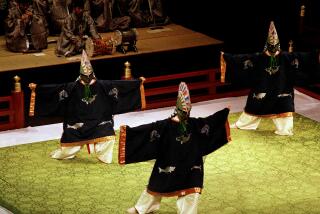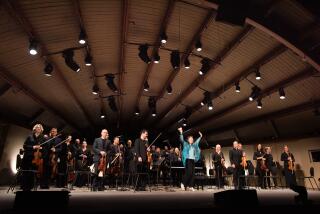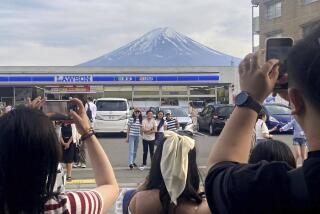Crowds Crimp Ojai Residents’ Music Appreciation
OJAI — For 50 years, the Ojai Festival has brought musical giants the likes of Igor Stravinsky and Aaron Copland to this little town to conduct their works under the oak trees of Libbey Park, securing for Ojai a place on the map of cultural landmarks.
The music festival has also brought thousands of tourists whose deep pockets have helped fill merchants’ registers and the city’s coffers year after year.
But it’s these same music-loving tourists who annually clog the town’s already overtaxed roads.
And as Ojai gears up for the three-day festival that opens today, residents are once again debating the merits of attracting large crowds of visitors.
“It’s already hard enough to get through town as is,” complained Aaron Malone, 23. “The music’s good, but the people are a bummer. That’s what it comes down to.”
Resident Tim Twombly, 44, said he dreads the out-of-town drivers.
“We have trees in the middle of some of our streets, and visitors aren’t real used to that sort of thing,” Twombly said. “All those people driving through town increases the likelihood of fender-benders.”
But city officials and merchants counter that the festival, which is expected to attract more than 5,000 visitors this year, lends Ojai a certain amount of cultural cachet.
“It’s a very healthy event for us,” said Daniel Singer, assistant to the city manager. “It establishes Ojai as a cultural and artist community. Ask someone in L.A. if they’ve ever heard of Ojai, and they’re like, ‘Sure, that’s where the music festival is.’ ”
That cachet also brings in tourist dollars--something Ojai depends on to pay for other programs. Two-thirds of the city’s $3.2-million budget comes from sales taxes and the bed tax, Singer said.
And with all the city’s hotels, motels and bed and breakfasts sold out this weekend, Ojai is set to bring in more than $8,000 in bed taxes alone, Singer said.
*
“You also have to consider where people are buying their gas, clothes and food,” he added.
Hallie Katz, owner of Human Arts, an art gallery in the Arcade, said the festival is a major annual event for her store.
“We’re gearing up,” Katz said. “We sent out our newsletter and stocked up on new artwork. It’s a big to-do for us.
“The festival brings a sophisticated group of people who like the arts . . . and who buy art. It’s one of our busiest weekends. We even host a reception for customers.”
Philippe Berger, chef and manager at Roger Keller’s, said the restaurant is packed during the festival.
“We love it,” Berger said. “We should have the festival every month.”
But Singer said complaints from residents of too many tourists and too much traffic aren’t uncommon. The city, he said, is struggling to strike the right balance between tourism and authenticity.
“First and foremost, we want to remain a community where people live,” Singer said. “We don’t want to be a tourist town like Solvang. People call Ojai ‘the hidden secret,’ and I think we want to keep it that way.”
But money’s money, and Ojai’s coffers need filling every year, Singer conceded.
“Residents recognize that our ability to be a healthy city is dependent on our ability to bring other people in to spend money,” he said.
*
Fifty-year resident Sharon Booth said that bringing culture to Ojai is worth certain sacrifices.
“I’m willing to put up with a little extra traffic to support a cultural addition to our community,” she said.
“The festival is good for the city.”
More to Read
The biggest entertainment stories
Get our big stories about Hollywood, film, television, music, arts, culture and more right in your inbox as soon as they publish.
You may occasionally receive promotional content from the Los Angeles Times.










